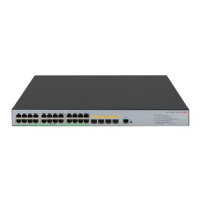256
Ste
Command
Remarks
7. Soft-reset MBGP connections
manually.
refresh bgp ipv4 multicast { all |
ip-address | group group-name |
external | internal } { export |
import }
Optional.
Enabling the MBGP ORF capability
The MBGP Outbound Router Filter (ORF) feature enables an MBGP speaker to send a set of ORFs to its
MBGP peer through route-refresh messages. The peer then applies the ORFs, in addition to its local
routing policies (if any), to filter updates to the MBGP speaker, reducing update messages and saving
network resources.
After you enable the BGP ORF capability, the local BGP router negotiates the ORF capability with the
BGP peer through Open messages. That is, the BGP router determines whether to carry ORF information
in messages and, if so, whether to carry nonstandard ORF information in the packets. After completing
the negotiation process and establishing the neighboring relationship, the BGP router and its BGP peer
can exchange ORF information through specific route-refresh messages.
For the parameters configured on both sides for ORF capability negotiation, see Table 7.
T
o enable the MBGP ORF capability:
Ste
Command
Remarks
1. Enter system view.
system-view N/A
2. Enter BGP view.
bgp as-number N/A
3. Enable BGP route refresh for a
peer or a peer group.
peer { group-name | ip-address }
capability-advertise route-refresh
Optional.
Enabled by default.
If this feature is not enabled, you
need to configure this
command.
For more information about the
command, see Layer 3—IP
Routing Command Reference.
4. Enable the non-standard BGP
ORF capability for a BGP
peer or a peer group.
peer { group-name | ipv6-address }
capability-advertise orf non-standard
Optional.
By default, standard BGP ORF
capability defined in RFC 5291
and RFC 5292 is supported.
If this feature is not enabled, you
need to configure this
command.
For more information about the
command, see Layer 3—IP
Routing Command Reference.
5. Enter MBGP address family
view.
ipv4-family multicast N/A

